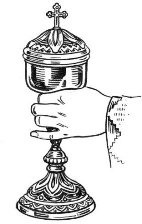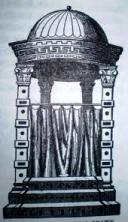 A priest acquaintance, Fr. Bede Rowe, has on his interesting blog A Chaplain Abroad, an entry about a veil for a ciborium.
A priest acquaintance, Fr. Bede Rowe, has on his interesting blog A Chaplain Abroad, an entry about a veil for a ciborium.
A ciborium is a sacred vessel which resembles a chalice but with a cover used for hosts to be consecrated and consecrated Hosts to be reserved in the tabernacle for distribution.
Since a ciborium is a sacred vessel, it ought to be consecrated, like the hands of the priest who carry them.
 Ciborium is also an feature of a sanctuary of a church, the canopy on columns over an altar. It is also called a baldachin.
Ciborium is also an feature of a sanctuary of a church, the canopy on columns over an altar. It is also called a baldachin.
The sign that the Eucharist is present is first and foremost the veil. The baldachin is the veil over the altar. There should be a veil over the tabernacle when the Eucharist is present. When the Eucharist is carried away from the altar, expect for distribution to the faithful, a canopy or ombrellino is used.
Think of it this way. In the Old Testament, when God descended on the mountain or the tent to speak with Moses, the place was engulfed by a cloud into which Moses had to enter. This was a manifestation of God’s divine attribute of glory. The veil on sacred vessels hearkens to this glorious cloud.
The ciborium, even in the tabernacle, ought to have a veil over it. I have noted that in many parish tabernacles, ciboria don’t have veils.


































I always thought the cover of the ciborium was, in a way, it’s own veil.
Thanks for the correction, Father.
Whoops — ‘its own veil’ not ‘it’s own veil’.
Dangers of autofill and hastily pressing “POST”…
This is what we have at my parish. A veil on the ciboria which holds the reserved Sacrament. There is also a veil behind the tabernacle door which the veiled ciboria rests behind. And, we also have a baldichins above the altar.
Fr. Rowe seems to assume that the sacred vessel for carrying communion hosts is made of silver. Many such ciboria are made of silver, others of brass, gold plated, etc.
Also, the veil is not necessarily round; it can have a center that is approximately the diameter of the top of the ciborium, with 4 strips of material sufficient to veil the ciborium as they hang down on four sides. Sometimes such veils are made from four pieces of material, angled and sewn together at the top. The sides may have decorations or lettering, such as IHS or XP, indicating the presence of Christ. In a larger parish where many priests celebrate mass, the presence of the ciborium veil serves the important purpose of identifying which ciborium has consecrated hosts and which has not.
Unfortunately, many supply houses do not carry ciborium veils. The ciborium veil fell into disuse during the sixties and seventies. I am not sure if/when the requirement for the use of a ciborium veil was changed.
My parish priest told me the the chalice veil represents Christ’s garments and that when it is removed at the beginning of the Liturgy of the Eucharist by the priest or deacon in the OF, it represents the stripping of Christ’s garments by the Roman guards. Is this true?
I have noted with pleasure that the OF Masses I have attended and that were celebrated by priests of Opus Dei almost always have ciborium veils in use.
WOW. Many Priests have been either thinking, “arguing,” or “making suggestions” about this specific topic lately!
However, Fortescue should not be given all the glory, as there were other Rubricians (and books) just as great as Fortescue when it comes to Rubrics (Jeffrey Collins, L. J. O’Connell, Ludovico Trimeloni, Matters Liturgical, Follow the Rubrics, etc).
The point that is missing here, however, and that many people *confuse* is that the veil (according to many Rubricians) should be used regardless of whether the Ciborium contains consecrated particles or not. Fortescue himself (first two editions) did not seem to want to go that far and said only that a Ciborium with consecrated Hosts is to be covered (but he did not say that a Ciborium that contains unconsecrated Hosts is not to be covered). O’Connell seems to have clarified this point in later editions (3rd thru 12th) and added that it is to be veiled even when it does not contain Consecrated Hosts as long as it is exposed to public view.
Sacred Vessels (whether blessed like the Ciborium or Monstrance or consecrated like the Chalice and the Paten) should be veiled when exposed to public view before/after Mass or some other liturgical (or quasi-liturgical) service. Obviously, they are to be unveiled when they are beign used to make the covering and uncovering less complicated.
Examples that lead to this conclusion:
1) The Chalice is covered from the very beginning of Mass until it is used at the Offertory even though before this it contains nothing inside.
2) The Chalice is covered after the Ablutions even though it contains nothing inside after it is purified and dried.
3) The Monstrance is to have its own veil and it is to be covered when exposed publicly (SRC n. 4268 ad vii), except when it is actually being used for Exposition.
4) The Paten is covered when not in used. At Low/Sung Mass, it is to be covered with the Corporal and Purificator when it does not contain the Host to be Consecrated. At Solemn Mass, the Subdeacon uses the Humeral veil to cover it while he holds it until he has to give it to the Deacon at the Our Father.
Trimeloni says: “Infatti il principio generale è che i vasi sacri vanno coperti, non
quando contengono le sacre specie, ma sempre quando sono all’altare e non servono per l’attuale ministero, come le rubriche e i decreti prescrivono espressamente per il calice e l’ostensorio.”
Matters Liturgical: “It is recommended … that a ciborium should be veiled when it is brought to the altar with small hosts to be consecrated and that it should remain veiled until the beginning of the Mass).
Fortescue-O’Connell: “When it [Ciborium] contains the Blessed Sacrament, or when exposed to public view (e.g. on the altar before Mass awaiting consecration), it should be covered with a veil of white silk.”
Jeffrey Collins: “Strictly speaking it [Ciborium] should also be veiled until the Offertory … as it becomes a sacred vessel.”
And, of course, for those who say that it would be confusing to cover it when it does not contain Consecrated Hosts — we ask: In such case, why should it be outside of the Tabernacle from the beginning of Mass then? If the Ciborium contains Consecrated Hosts, it should remain in the Tabernacle until it is going to be used for the distribution of Communion. Right?
To highlight a side point made by Latinmass1983: in the EF Roman Ritual the ciborium is only blessed, and not consecrated. Although the blessing is a reserved blessing, nevertheless, it is still only a blessing in which the sign of the cross is made over the vessel.
On the other hand, the chalice and paten in the old ritual are consecrated by a bishop using the sacred oils. The consecration can be delegated to a priest, but the oils are still used. This consecration of the chalice and paten are similar to the consecration of the priest’s hands at the ordination ceremony where the hands are anointed with holy oil.
Therefore it would seem that the proper terminology is to say the ciborium is blessed, and the chalice and paten are consecrated.
In my parish, have not seen one of those in years. Our sacristy contains beautiful chalices and ciboria, all of which go unused. For Mass, the priests do not use a celebrant’s chalice but instead use one of the two simpler chalices that are used by the EMHCs at Communion. Similarly, a priest host is not used but one of the small hosts for the faithful is used for the elevation.
At my “Active Participation” parish, I have not seen a ciborium veil, or, for that matter, a ciborium for many, many, many years. We see low, gold bowls, spread out on the altar, matching “people’s” cups on the other side of the altar, and any hosts brought from the tabernacle are in the same low, gold bowls. There has never been, in my 40+ years of belonging, a veil on the tabernacle. Sad, sad, sad…..
Pingback: WEDNESDAY MORNING EDITION | ThePulp.it
When I was an altar boy and it was necessary to handle the ciborium (and needless to say it would only have contained unconsecrated elements) I was instructed not to touch the vessel directly, only through the veil, which I assumed, rightly or wrongly, had a practical rather than a symbolic function.
We often attend the Extraordinary Form Mass at St. Ann’s Church in Erie, PA and I have never seen a ciborium veil and for that matter the ciboria don’t even have tops on them. They are simply put in the tabernacle open as if putting a cup in a cupboard. I won’t say anything because most priest in Erie don’t care any way.
So, would this be why the monstrance is veiled too at times?
In my parish, our new rector has ceased using the ciboria veils that our previous past had brought back, removed the tabernacle veil, and discontinued daily Eucharist Adoration. I guess this isn’t saying much as, apparently, our bishop has issued instructions that the chalice veil and burse may only be used when celebrating the Traditional Latin Mass. It cannot be used when celebrating the Novus Ordo so the cessation of the ciboria and tabernacle veils may be due to other instructions from our bishop that I am not privy to.
I trust that the Church has a good reason for this veil – my question does not intend to doubt this fact, I’m merely looking for an explanation. Why is a veil appropriate given the tearing of the curtain during the crucifixion of Our Lord? Doesn’t that suggest that Christ is no longer veiled to humanity, but is now fully revealed? And doesn’t that indicate that the use of the veil to cover Our Lord would be inappropriate?